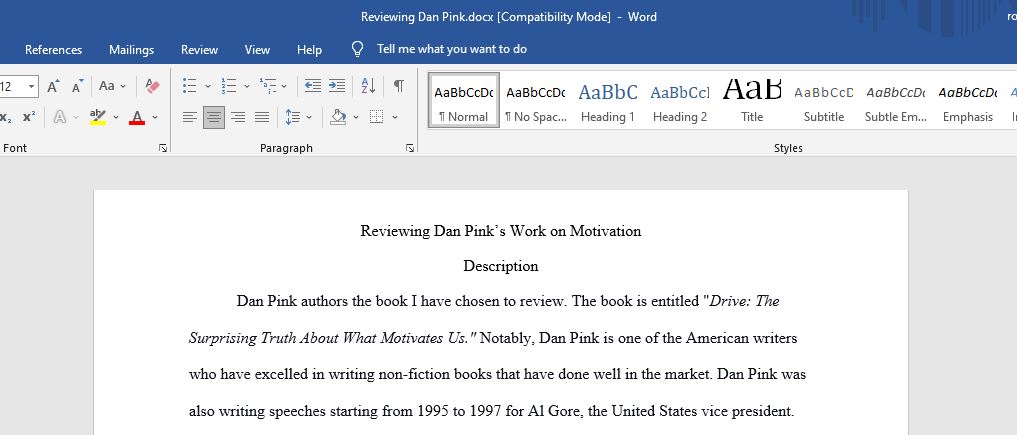Reviewing Dan Pink’s Work on Motivation
Select a book that either addresses an area of business in which you have an interest or a book that addresses the business side of the professional practice you wish to open or in which you might practice. Write a review of that book. You may select any of the books on the bibliography I have provided or make your own selection based on your specific interests.
The following is a tool developed by a faculty member at Butte College to help students writing a non-fiction book review. I think this will help you as you proceed with this assignment. The website for what follows is: https://www.butte.edu/departments/cas/tipsheets/style_purpose_strategy/non_fiction.html
WRITING ABOUT NON-FICTION BOOKS
At some point in your college career you may be asked to review a non-fiction book to enable you to learn more about some aspect of your course work. The assignment is demanding because you are required to describe and evaluate an author’s contribution to a subject that you may know little about. How should you proceed?
Your instructor will usually offer some guidance, such as a suggested list of books or some guidelines to follow in selecting a work. Generally, you should try to find a relatively recent work of about 200-350 pages on some aspect of the course that particularly interests you.
Describe and evaluate
You are expected to describe the book, that is, to summarize some major points of interest, and to evaluate it, that is, to make judgments about it. The areas to address include the following:
Description
Information about the author
Background information about the book
Author’s purpose-to inform? Entertain? Persuade?
Author’s thesis
Organization
Summary
Evaluation
Other reviews
Scholarship
Strengths and weaknesses
Later you may decide to omit some of these points. Their order may be changed, with more important or striking matters appearing first. Usually the descriptive section appears first in non-fiction reviews, especially in scholarly journals. All these organizational decisions are subjective and can be revised as needed.
While reading the book, take notes of the passages and their page numbers that relate to how you can describe and evaluate the work. In particular, be on the lookout for thesis statements, chapter summaries, striking quotations, discussions of methodology, conclusions, and author’s recommendations. If you question whether or not to take a particular note, remember that it would be wiser to err on the side of having too many, rather than too few. You can always eliminate notes that appear unnecessary.
Points of description
Information about the author may appear on the book jacket or may be obtained or inferred from what is written in the preface. In order to determine to what extent the author is an authority on the subject, you should do some library research into the author’s present position, background, experience, and qualifications. Biographical sources such as the Biography Center in the GaleNet database will help you find this information. It need not be much, perhaps just a sentence; at most, it might consist of a short paragraph.
Background information about a book consists of the historical, sociological, economic, scientific or other circumstances that may have influenced or contributed to its publication. This information may have some bearing on the book’s importance or interest.
Often the author’s purpose–to amuse, inform, persuade-will be apparent from the preface or introduction.
The thesis or central idea of the book will probably be stated in the introduction or the conclusion. To gain an overview of the book that will help you realize its purpose and main ideas, read the preface and the introductory and concluding chapters first.
The organization of non-fiction depends partly on what kind of non-fiction it is-philosophy? Biology?–and partly on the author’s purpose. History, for example, might be organized either chronologically or around central issues. Or, if the author’s purpose is to challenge a widely-held position, he may choose to refute ideas point-by-point. Look at the table of contents and, as you read, refer back to it.
Because so much depends on your audience, the summary may be one of the most difficult parts of the review to write. Are you writing only for your instructor who has probably already read, or is familiar with, the book? Are you writing for your classmates who have not read it? Or are you writing for other people who are not in the course and are therefore unfamiliar with the subject? Your instructor can tell you what audience the paper should address. Then you will be able to judge how thorough your summary should be and whether or not terms should be defined and points explained in detail.
Answer preview:

word limit:1165
